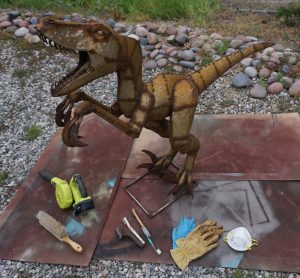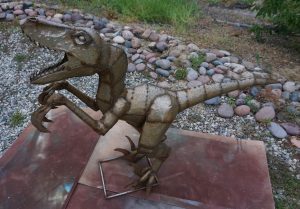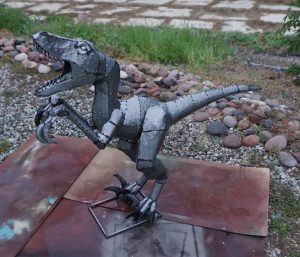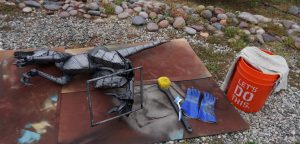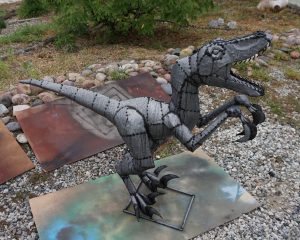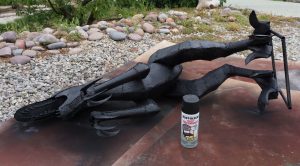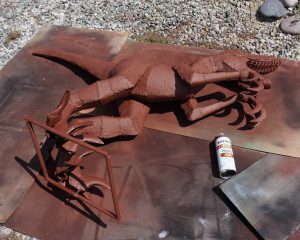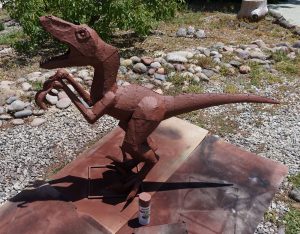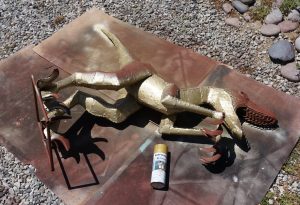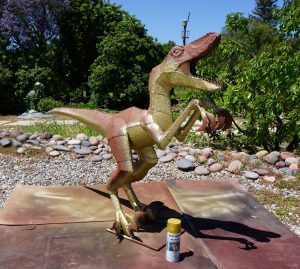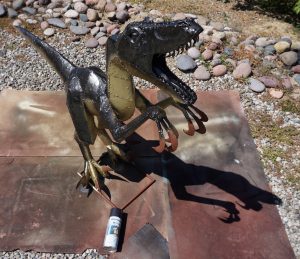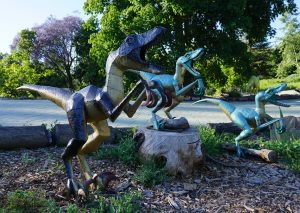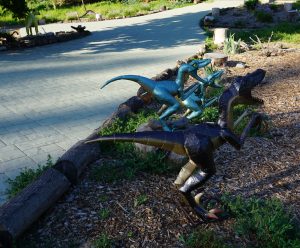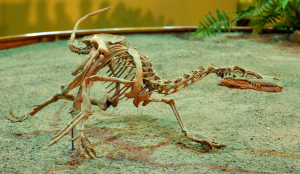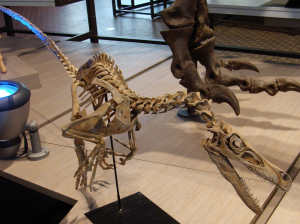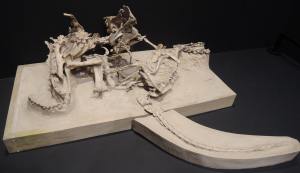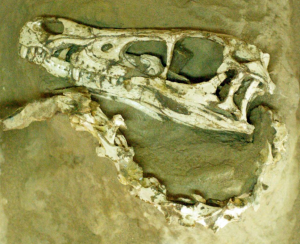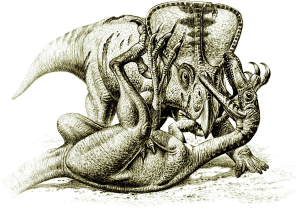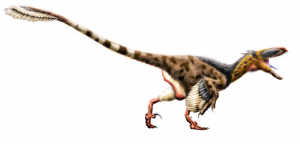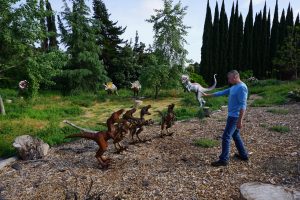Jadon was a little impatient after seeing Blue’s & Charlie’s progress. So, here we go again –
1st Step: Wire Brushing. Have the Proper Tools & Protection – Leather & Blue Nitrile Gloves, Various Sizes Wire Brushes, Dusting Brush, Blower, Protective Clothing, Knee Pads, Hat & Eye Wear. I start with the Jadon on his side to clean the bottom frame, inside the legs and the tight spots underneath. The knee pads are helpful for this part of the process. Upright to finish, dusting brush and blower to clean area.
2nd Step: Acid Wash. Supplies needed Protective Clothing, Hat, Rubber Gloves & Eye Wear; Brushes; Spray bottle; Etching Acid; measuring cup or other container to transfer Etching material to spray bottle. Again, start with Dinosaurs on their side same reasons as above. Upright to finish. Remember to be very careful when spraying the etching acid. A gust of wind or quick change in its direction can blow the material back on You! Always make sure you keep the little ones and pets out of range, as well. The brushes help with getting the material into heavy rust areas. Let set over night.
3rd Step: Acid Rinse. Supplies needed Protective Clothing, Hat, Rubber Gloves & Eye Wear; Brushes; Towel, Bucket & Water. For a large Dinosaur you may wish to use a hose. But for this size a bucket of water is all I need. Save water whenever you can! A damp towel is great for the final wipe down after brushing. Let Dry Completely.
4th Step: Rust Reformer. After You’re sure the Dinosaur is dry, spray on the Rust Reformer to provide a nice seal. Again, starting on the side. After a couple hours upright to finish. You may like the flat black look and decide to clear coat at this step. Or maybe add a few details eyes, etc.… and then clear coat.
The flat black is inspiration for Jadon’s color scheme.
5th Step: Primer. I use the Rusty Brown Primer. I have used the white before too. If your base colors are very light you might consider the white primer. After a day or two for curing, it’s time for color.
6th Step: Painting. Gold Rush Metallic will be the underside color with Black Night Metallic for the top color. After allowing a day to cure, the Claws will be masked off with blue tape and plastic bags. Hammered Brown will be used for the Claws and base frame.
Raptors feet & legs most closely resemble Eagles & Hawks. The Bird connection continues with Wishbones, brooding their Nests, Hollow Bones and covered in Feathers – Fiber like Feathers on most of their Bodies for warmth and many believe Modern Feathers on their Arms. The Feathers on their Arms may have been for Display, Aid in Balancing when Attacking Prey with their Sickle Claws and perhaps to add Speed & Thrust when Running Up Inclined Slopes.
The Fossil known as “The Fighting Dinosaurs” is of a Velociraptor and a Protoceratops. This fossil is very well preserved indicating they were buried fast. A rapid sand storm or collapsing sand dune are possible scenarios. The scleral rings in the eyes suggest that Velociraptor may have been nocturnal and the Protoceratops cathemeral – active during the day. Besides Protoceratops, Tenontosaurus was a favorite meal for Dromaeosaurs – juvenile Deinonychus in particular. Tenontosaurus weighted up to 2425 lbs., 23 – 26 feet long and up to 6.5 feet high at the hip. Check Out these Dinosaurs at Your Local Library, on Wikipedia or see them in person at the Museum! Check Your Museums website or call them about their Dinosaurs on display. Museums have massive Libraries too! Contact them to find out how you can access them.
Thanks to Ben Townsend from Blacksburg, Virginia for his photo of V. mongoliensis at the Wyoming Dinosaur Center; Eduard Sola’ Vázquez for his photo of V. mongoliensis cast at the Museum of Natural Sciences Brussels; V. mongoliensis and Protoceratops andrewsi in “Fighting Dinosaurs” specimen photo by Yuya Tamai from Gifu, Japan; Skull of V. mongoliensis in “Fighting Dinosaurs” specimen photo by Thomas Vandenberghe from Leuven, Belgium; Artist rendering of “Fighting Dinosaurs” by Raul Martin photo “A Field Trip to the Mesozoic Chiappe LM PLos Biology Vol. 1, No. 2; Artist rendering of Achillobator photo by Durbed line drawing by Pilsator. The Achillobator drawing is a great illustration of the fuzz like feathers on most of the body with the typical feathers on the arms of a raptor. The Artist rendering of “Fighting Dinosaurs” reflects the pre-feather knowledge of Dinosaurs.
Michael Crichton the author of the 1990 novel “Jurassic Park” based his raptors on Deinonychus. However, word has it that he thought the name Velociraptor sounded more dramatic. This carried through to the “Jurassic Park” movies.
I discovered a fun book at the City of Camarillo Public Library: “The Mysterious Tadpole” by Steven Kellogg. This Tadpole Surprises Everyone! No spoilers you’ll have to read it to find out how. Recommended for 5 to 8, but I believe All will find it Fun! Check It Out! Visit Your Local Library.
Stay Tuned for additional Color Splashes for All Four and More Dinosaur Fun Facts!
“Antarctic Dinosaurs”
are waiting for You at
The Natural History Museum in Los Angeles
This is a Special Exhibit ending January 5th!
“Encouraging the Appreciation of Art and Education through the Inspiration of Dinosaurs”
Paul & Prehistoric Pals
Your feedback is appreciated, Thank you
